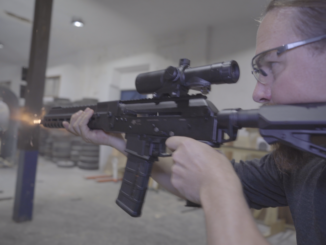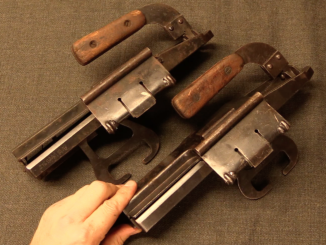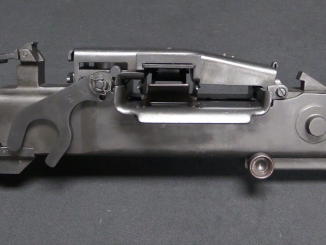A lot of people think that the US was the only country in World War II to mass-issue a semiautomatic infantry rifle, but that isn’t true. While the US was the only country to issue *everyone* a semi auto, both the Soviet Union and Germany produced large numbers of them. The Soviet rifle in particular was developed over pretty much the same timeline as the M1 Garand, and literally millions of them were made and used in the war.
Today we are taking a look at the second Soviet self-loader adopted as an infantry standard, the SVT-38. The SVT was actually the runner-up up in the formal Soviet trials, and a rifle made by Simonov was actually adopted first in 1936 – but it proved too fragile in field use, and Tokarev’s rifle was brought in to replace it. The weapon was only made for a couple years before being updated to the SVT-40, and today the 1938 models are quite rare in the US.




“While the US was the only country to issue *everyone* a semi auto”
M1903 Springfield was still used by some Marine Corps during battles on Pacific islands.
This is inverted situation to Soviet Union, where SVT rifles were popular amongst Naval Infantry. Photos of Naval Infantry:
http://102rota.ru/morskaya-pehota-rossii/morskaya-pehota-vo-vremya-velikoy-otechestvennoy-voyny
suggest that sub-machine gun also were popular, notice widespread usage of machine gun belts in lieu of bandoliers.
The 1940 Tokarev also came with a selective-fire version, the AVT-40, with a beefier woodwork and a letter A impressed into the stock. The selector was incorporated into the safety lever at the rear of the trigger guard: lever down was SAFE, blocking the trigger, lever all the way to the left was SEMI and lever all the way to the right was AUTO.
One the less known interesting off-spring was the AKT-38, which was a select-fire carbine version. If the rifle-size was troublesome in full-auto, what do you think the carbine-sized was good for? Not much, and so it was just a handful of these – but still they were enough of them to warrant an official NSD manual being printed.
https://ru.wikipedia.org/wiki/Самозарядная_винтовка_Токарева
Full-auto carbine АКТ-40 was tested, results of tests were:
Dispersion (distance: 100m, weapon on rest):
9 cm – semi-auto mode
70 cm – full-auto (short burst)
100 cm – full-auto (long burst)
I recall reading, many years back a book written by Russian writer. It captured events since beginning of German invasion. He stated repeatedly that soviet soldiers used what he called “semi-automat”.
Two thing which strike me looking at SVT40 (and I have seen one in person before) is relatively good quality of workmanship and the fact it does not have stiffening/ guiding ribs on magazine. Does anyone else have same observation?
The number of baffles on muzzle brake is another item which gets my attention. I count six of them per each side. What was the reason for so many so far from chamber? In case in AK74 we see just 2 – one per each side.
I also recollect reading that it was Stalin, who put his favour behind Tokarev’s rifle over competition.
The later production guns had fewer baffles. Stalin was a patron of Simonov, hence the adoption of the avs-36 over tokarev’s design.
“The number of baffles on muzzle brake is another item which gets my attention. I count six of them per each side. What was the reason for so many so far from chamber? In case in AK74 we see just 2 – one per each side.”
If I am not mistaken 6-hole muzzle brake is more effective, when 2-hole is easier to manufacture. AK-74 use less powerful cartridge.
Stalin favored Tokarev, because he had designed some successful weapon for Red Army: MT (Maxim-Tokarev), TT-30 automatic pistol, TT-33 automatic pistol. Simonov was newcomer – AVS-36 was first weapons adopted by Red Army bearing his name.
On the other hand AVS was better for production – SVT-38 consist of 143 parts (including 22 springs) and 12 various steel types were needed (according to Д. Ф. Устинов, then нарком вооружения ~Secretary of Weapons), Red Army paid (in 1939) for SVT: 2000 rubles, for Simonov rifle with spare parts: 900 rubles, and for comparison:
for DP with spare parts: 1150 rubles, for DT with spare parts: 1400 rubles, for Maxim without mount but with spare parts: 1760 rubles.
Back about 1968, I bought an SVT-40 for $100. I repaired a small crack at the wrist of the stock, and sold it a few years later when I got married. Ammo was a bit scarce back then, and I always regretted that I never fired it.
I do believe the SVT-38 was capable of mounting a bayonet, as shown in this 1940 Russian manual:
http://imgur.com/xY1A1do
Do both of these weapons have fluted chambers? Or is it just the SVT-40?
Much like the M1 Garand, the Tokarev prototype also used an unusual Primer Actuated Blowback operation. This operation would be highly reliable depending on the cartridge/propellant.
Looks Finned to me. Matter of fact, the majority of SVT-38’s in the US were imported from Finland after they “liberated” them from the Soviets during the Winter War (mostly) and Continuation War (not likely many in circulation then, but they probably captured a few then as well). Any SVT-38’s coming to the US from Russia/Combloc nations would have been refurbed and would have plum bolts.
I might be sound silly,
However I say that German G43 way better and more secure to shoot than SVT40 or even worst earlier SVT38..
Russians was always complain lot about those rifles,AVS36 was also cost some parts damages like Ian mention firing pins and ejectors was the very bad parts that worn off,there also was some smaller parts in trigger mechanism and usualy sear area was fast to wear part especially if it was set on select fire….
The AVS 36 is striker operated unlike SVT40 hammer operated,
Somewhere in 1946 Sergej Gavrilovich Simonov redesigned his final version of rifle but he choose to cut some length of barrel and that how SKS Karabine was born..
Both as you can see SKS and SVT 40 parts near identical in construction and both rifles is operated by tilting bolt mechanism like STG44,Bren or even Japanese type 64 automatic rifle…
Funny part that main housings looks near identical in design which is not hard to guess that one rifle was improved based on first model…..
Simonov knew that SVT40 have no further future need for Soviet army and he also knew that SVT40 had lot of jamming problems until he made his own version known as SKS..
I shoot SKS numerous times and not even single misfire it gave me,
There is at least 4-6 types of SKS exist,the best version of SKS is model 45 which have threaded barrel,model 56 have press inn barrel but further than that not much differences between them,bayonets however appear in 2 different shapes one like spiked knife while other is like ice pick..
SKS is light weight designed rifle,
It could be pushed to numerous punishments like full auto conversion,bipod attachment,sniper scope attachment,attach larger capacity magazines even 64 round drums everything would work..
The best SKS to have with chrome lined barrels that prevent corrosion..
I have Norinco SKS,very trusted piece of machinery and despites country of manufacture or writings it consider standart SKS rifle and unchanged in design and construction..
More rare SKS that main housing made out of sheet metal by some reinforced inserts,still is unknown why those types of SKS was made on first place for??
Germans and Russians finaly realized at end of World war 2 that best rifle is not depand on longer barrel length but on it’s mechanical construction…
G43 and SKS have both near identical barrel lengths and because of different types of ammunition they fires on different ranges with different penetrating result….
G43 and SKS very easy to understand and to be trained with despites something like Sig Sauer,Heckler and Koch or even Beretta..
The best weapon that is very affective is that type of weapon that have less amount of moving parts and simplicity in construction….
For examples SKS and SVT 40 trigger mechanisms looks identical,SVT 40 bayonet pure copy from German 98 Gewehr or 98K..
The bayonets looks very long and huge and serves best as cutting knife rather anything else….
Becouse original 98 bayonets is super expansive I bought repro bayonet and it fits fine on my 98 gewehr…
The 98 gewehr longer and bulkier than its karabiner version also means it allow to shoot on far longer ranges up to 3000 meters or simply 3 kilometers with sniper scope..
The g43 maximum range is 1200 meters and in order to reach that range it recquires scopes far better than just ZF4,more like PSO-1 scope is a proper version but it recquires to be modified to properly sit on G43…
SVD Dragunov shoots little further up to 2500 meter range because of long barrel..
First there was SKS than even SKS became replaced by SVD Dragunov rifle…..
Iam less familiarized with SVD rifle but SKS I know very good as well as AKM rifle and Beryl plus VZ58 although it not AK related.
I also well trained with STG44 and Mp40 although those are old types of rifles and more and more get forgottened..
Yes it is totally true that without STG44 AK46 won’t be exist and further AK47 won’t be even born and without that M16 won’t be exist eather,both AKM and M16 operating by rotating bolt head..
As everyone can see further same M16 pattern bolt was adopted by British in their SA80 ad later L82A1 Enfield systems,G36 Heckler and Koch and lot of other different designs…
So as we see from one invention and design it leads into another design and further improvement….
Somewhere in 50s Eugine Stoner came to Russia studied and brought AK rifle as gift with him back to USA where he first invent his Stoner 63 universal rifle/machine gun platform and still those consider rare and expansive types of weapons..
Stoner 63 was first rifle trial series that passed USA weapon trials however was rejected because of costic production,later AR10 was born than M16A1 that used in Vietnam war than upgraded M16A2 that still in USA army use but more and more get replaced by Masada and FN Scar..
By the end of 2020 USA army would be equipped with FN Scar rifle series,Czech CZ 805 Bren is pure inspiration of FN Scar…..